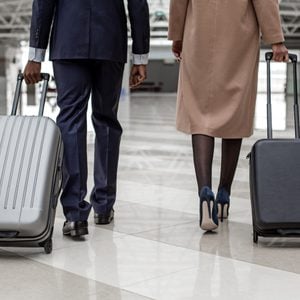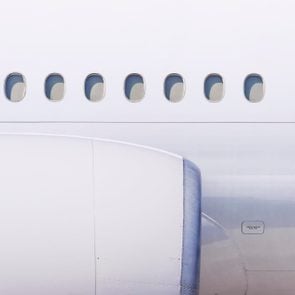Read this before you doze off midflight!

The Surprising Reason You Should Never Rest Your Head Against an Airplane Window

Who among us hasn’t fallen asleep on a plane with their head resting on the window frame? It’s a common habit—but it may be a bad idea, according to a flight attendant who warns against the practice in a TikTok video.
So is this new airplane rule about safety, etiquette or something else? To find out, we dug into the research and grilled three leading experts to get the bottom line.
Get Reader’s Digest’s Read Up newsletter for more travel, tech, books, humor and fun facts all week long.
Why shouldn’t you rest your head against an airplane window?
Spoiler alert: It’s germier than you’d think. As the TikTok tipster, Tommy Cimato, points out, “you don’t know how many people or children have wiped their hands or other things all over the window.”
@tommycimato #greenscreen #fyp #flightattendant #airline #aviation #travel #flights ♬ Blue Blood – Heinz Kiessling
In fact, the window and surfaces near it can harbor nasty microbes, according to microbiologist Jason Tetro (aka the Germ Guy), author of The Germ Code and host of The Super Awesome Science Show podcast. And they aren’t the bugs you might be expecting.
Scientists know that high-touch surfaces—spots that make contact with many hands—are hot spots for transmitting germs in restaurants, public bathrooms and, yes, tin boxes in the sky. “In general, you’re going to find microbes on what we call high-touch surfaces, or areas that are touched repeatedly by multiple individuals,” says Wesley Long, MD, PhD, medical director of diagnostic microbiology at Houston Methodist medical center. “Some of these areas may get cleaned more thoroughly by the cleaning crew than others.”
Exactly what kind of germs can end up on plane windows?
An airplane’s window area can be a petri dish for germs like Staphylococcus aureus, which some of us have on our skin, as well as influenza A and other viruses, which can survive on surfaces for several hours, says Karen Duus, PhD, professor of microbiology and immunology at Touro University Nevada in Henderson.
In snoozing there, you also may be smooshing up against methicillin-resistant Staphylococcus aureus (MRSA), which can survive for about a week on the window frame or shade, Tetro warns. As you may have heard, MRSA is resistant to many antibiotics, so it is a health scourge. Because the window “is a nonporous surface—meaning it’s hard and doesn’t absorb liquids—any bacteria that has been transferred there can potentially end up on your skin and possibly nose,” Tetro says.
What are the chances that you’ll actually get sick from this?
Whether the bugs will give you a bug depends on many factors, including the type and number of germs you come in contact with, your immune-system health and the state of your skin. Staph or other pathogens could get on you, Duus says, “but if your skin is intact, they won’t be able to infect you unless you touch your face and transfer them to your eyes, nose or mouth.”
Another concern: picking up a nasty gastrointestinal infection. “There are some viruses, like norovirus or bacterial causes of foodborne illness, that could be found on these surfaces and make you sick, especially if you don’t wash your hands before eating,” Dr. Long says. Wipe down surfaces with a disinfecting wipe and wash your hands (or use hand sanitizer) before chowing down.
How often are airplane surfaces cleaned?

Surprisingly, there are no federal or international laws dictating how often airplane surfaces need to be sanitized. That means it’s up to individual airlines to create their own protocols. Most airlines do three types of cleaning, Tetro says.
-
Turnaround clean: a quick wipe-down (ideally using a disinfectant) between flights.
-
Overnight clean: a more thorough cleaning, which is done each night. “Sometimes ultraviolet light and electrostatic sprayers may be used to improve the coverage of antimicrobial activity,” Tetro says.
-
Deep clean: a less frequent, more intensive cleaning during which things like seats are taken apart and thoroughly disinfected. The airlines will do this on a set schedule and if something happens on board that makes the aircraft unsanitary—like in the case of the United Airlines biohazard incident, which involved a medical issue and the crew vomiting, in the summer of 2024.
The bottom line? Your seat area likely isn’t all that clean. “If you are on a late afternoon or evening flight,” Tetro says, “you’re probably sharing other people’s germs.”
What other habits should you avoid on airplanes?
We hate to break it to you, but the window isn’t the only unhygienic place on the plane. A Canadian Broadcast Channel (CBC) investigation swabbed surfaces on 18 flights and found E. coli, staph and mold on many high-touch plane surfaces, including the tray tables and seat pockets. With that in mind, you might want to avoid these habits:
Using your tray table without wiping it down
Since they’re used for everything and anything, tray tables are notoriously dirty. The CBC News testing found mold and hemolytic bacteria, a type that can break down red blood cells and is associated with illnesses including strep throat. The problem isn’t just that these trays get touched a lot, Tetro says, but also that “they get contaminated with foods and other nutrients that bacteria love.”
While most airlines deep-clean tray tables at night, they may not give them enough attention between the day’s flights. Don’t chance it: Wipe yours with a disinfecting wipe, and wash your hands and/or use alcohol-based sanitizer before eating.
Touching the bathroom-sink handle
You already know how germy bathrooms get: They’re home to dangerous microbes like E. coli. “A plane bathroom is the perfect mix for microbial messiness,” Tetro says.
The door handles tested by CBC News harbored hemolytic bacteria. Tetro recommends using a paper towel to protect your hands from the sink and door handles. And if you have to touch them? “Make sure to have hand sanitizer on the standby for when you get back to your seat,” he says.
Digging around in the seat pocket
The CBC News swab tests found E. coli, among other pathogens, in the seat pocket. How could germs like that get there? From dirty hands and people storing what they definitely shouldn’t there, like snotty tissues and—blech!—dirty diapers.
The fabric doesn’t help things, Tetro adds. “Nonporous surfaces mean that the bacteria will transfer as soon as there is contact,” he says. So it’s best to keep your book and gum in your bag instead of in this germ collector.
About the experts
|
Why trust us
At Reader’s Digest, we’re committed to producing high-quality content by writers with expertise and experience in their field in consultation with relevant, qualified experts. We rely on reputable primary sources, including government and professional organizations and academic institutions as well as our writers’ personal experience where appropriate. We verify all facts and data, back them with credible sourcing and revisit them over time to ensure they remain accurate and up to date. For this piece, Lisa Lombardi tapped her experience as a longtime health reporter and the author of What the Yuck?! The Freaky and Fabulous Truth About Your Body to ensure that all information is accurate and offers the best possible advice to readers. Read more about our team, our contributors and our editorial policies.
Sources:
- Tommy Cimato: “5 Things You Should Never Do on an Airplane”
- Jason Tetro, microbiologist, author of The Germ Code and The Germ Files, and host of the Super Awesome Science Show podcast; email interview, Sept. 24, 2024
- Wesley Long, MD, PhD, medical director of diagnostic microbiology at Houston Methodist medical center; email interview, Sept. 23, 2024
- Karen Duus, PhD, professor of microbiology and immunology at Touro University Nevada; email interview, Sept. 24, 2024
- CBC News: “What’s the Dirtiest Surface on an Airplane? The Results May Surprise You”


